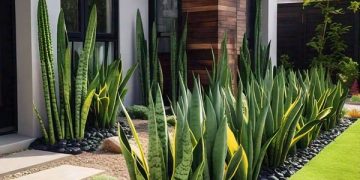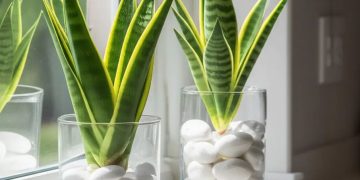Snake plants (Sansevieria), also known as mother-in-law’s tongue, are famous for their upright, sword-shaped leaves. When healthy, they stand tall and sturdy, making them a favorite low-maintenance houseplant. But if you notice your snake plant’s leaves curling, it’s usually a sign that something is wrong.
This guide explains the common reasons why snake plant leaves curl and how you can fix them to bring your plant back to health.
7 Causes & Fixes
1. Underwatering
Snake plants are drought-tolerant, but if left dry for too long, their leaves may curl inward to conserve moisture.
Signs: Wrinkled, dry, or crispy leaves.
Fix: Water thoroughly, allowing excess to drain out. Afterward, water only when the soil is completely dry. Learn more in our guide: How Often Should You Water a Snake Plant?
2. Overwatering
Too much water is one of the biggest killers of snake plants. When roots sit in soggy soil, they suffocate, leading to rot. As the roots weaken, leaves may curl, droop, or turn mushy.
Signs: Soft, yellowing, or curling leaves. Soil that stays wet for days.
Fix: Check the roots. If rotten, trim damaged parts and repot in fresh, well-draining soil. Reduce watering frequency.
3. Pest Infestation
Pests such as spider mites, thrips, and mealybugs can cause curling leaves. They suck sap from the plant, leading to distortion and stress.
Signs: Webbing, sticky residue, tiny white or black spots on leaves.
Fix: Wipe leaves with a damp cloth, spray with insecticidal soap or neem oil, and isolate the plant until pests are gone.
4. Too Much Direct Sunlight
Snake plants tolerate many light conditions, but prolonged direct sunlight can scorch leaves, causing them to curl or develop brown edges.
Signs: Curling along with bleached or scorched patches.
Fix: Move the plant to bright, indirect light. East- or north-facing windows are ideal. See our full guide: How Much Light Does a Snake Plant Need?
5. Low Humidity or Cold Stress
Sudden temperature drops or very dry air can stress your snake plant, leading to curling leaves.
Signs: Curling with browning tips, especially in winter.
Fix: Keep your plant away from drafty windows, heaters, or air conditioners. Snake plants do best at 60–85°F (15–29°C).
6. Rootbound Plant
If your snake plant has outgrown its pot, roots can become crowded, restricting water and nutrient absorption. This stress can cause curling.
Signs: Roots circling inside the pot, soil drying out too quickly, stunted growth.
Fix: Repot into a container 1–2 inches larger with fresh, well-draining soil.
7. Nutrient Deficiency
Although snake plants don’t need frequent feeding, a lack of nutrients—especially magnesium or nitrogen—can cause curling or discoloration.
Signs: Pale, curling, or weak leaves.
Fix: Use a balanced houseplant fertilizer (diluted to half-strength) once every 4–6 weeks during spring and summer.
FAQ About Curling Snake Plant Leaves
1. Can curled snake plant leaves straighten again?
Yes, if the problem is caught early and corrected. Severely damaged leaves, however, may remain curled and should be pruned.
2. Should I cut off curled leaves?
If the leaves are badly curled, yellow, or mushy, trim them at the base. This helps the plant redirect energy to new healthy growth. Learn how in: How to Trim a Snake Plant.
3. How often should I water my snake plant to prevent curling?
Water only when the soil is completely dry—typically every 2–3 weeks, depending on temperature, humidity, and light.
4. Can too much fertilizer cause curling?
Yes. Overfertilizing can cause salt buildup, burn the roots, and lead to curled or damaged leaves. Always dilute fertilizer.
5. Do snake plants like misting?
No. Snake plants prefer low to moderate humidity and don’t benefit from misting. In fact, excess moisture on leaves can invite pests or fungal issues.
Final Thoughts
Curled snake plant leaves are usually your plant’s way of signaling stress. Most of the time, the cause is improper watering, pests, or unsuitable light. By identifying the issue early and making small adjustments, your snake plant will recover and regain its strong, upright appearance.
















